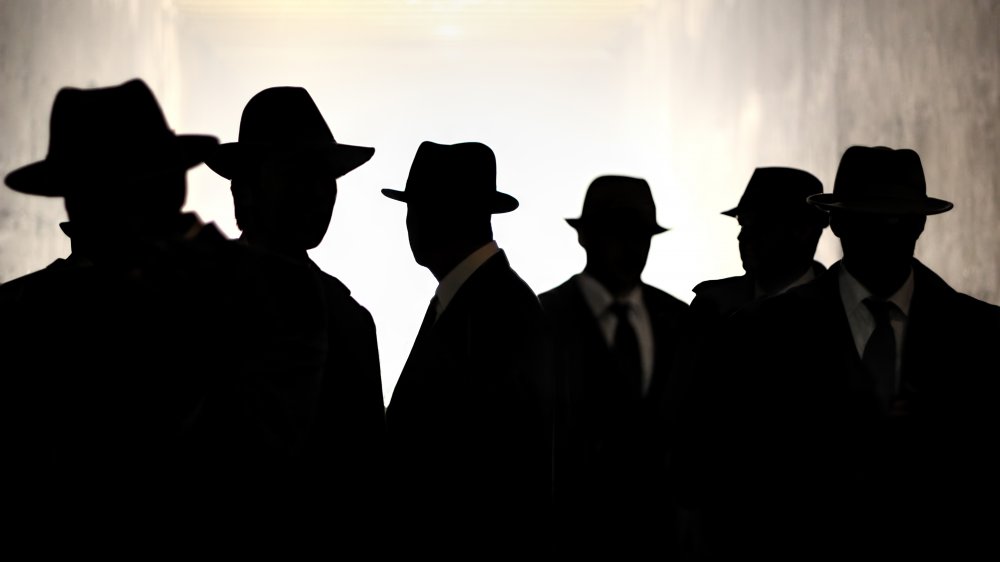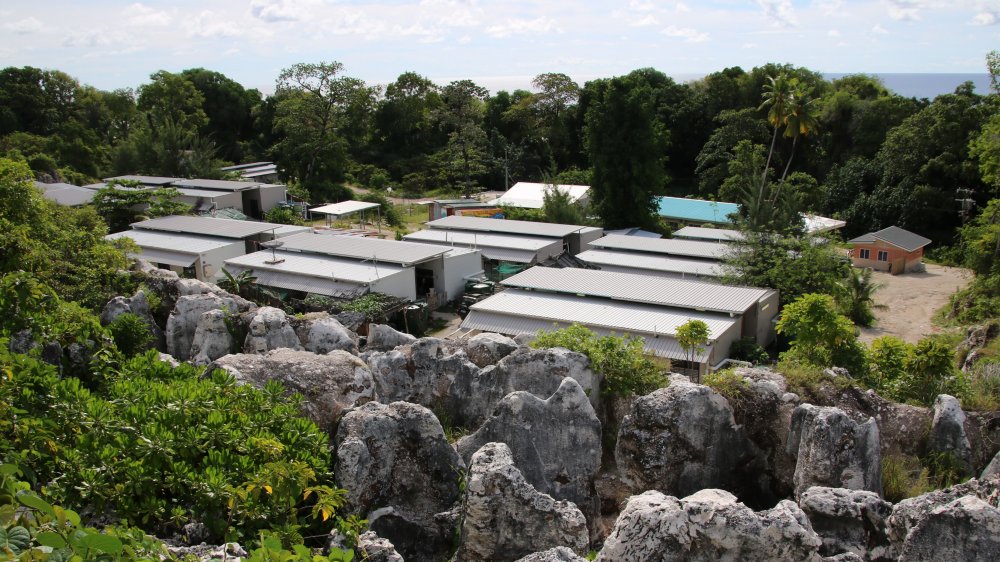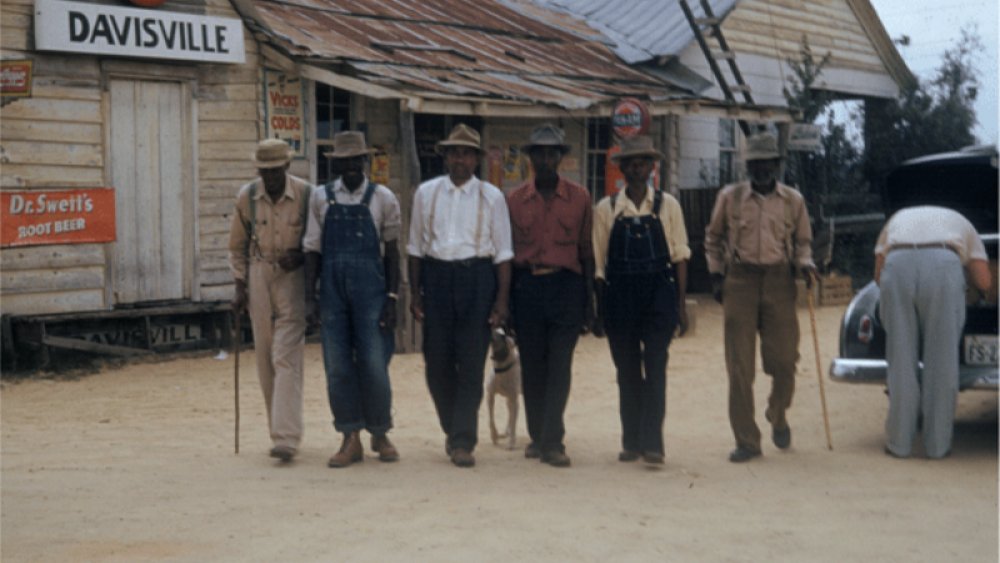Government Stories That Are Super Shady
"There are three types of lies," Benjamin Disraeli said. "Lies, damn lies, and statistics." A 2010 study found that the average person lies just under twice per day — which, of course, just so happens to be a statistic. The point is, people lie, and let's face it: they probably lie a lot more than they're willing to casually admit to an earnest academic with an official-looking clipboard.
It's not all that surprising, then, that governments, being made up of lots of people with a vested interest in keeping other people happy (particularly the people who vote), don't exactly have a squeaky clean record for telling the truth. How do governments play loosey-goosey with the truth? How do they (sometimes) manage to get away with it? And who wins and loses from this constant barrage of white, gray, and outright black government lies? Read on, and all will be revealed. Honest.
Kim Jong Il's godly golf game
Shady government cover-ups have a rep for being pretty serious business. Tales of such shenanigans tend to involve big things, like nefarious assassinations or covert alien autopsies (puhlease). At the very least, they tend to suggest something sordid and deviant happening behind thick, velveteen curtains of privilege in an out-of-the-way corridor of power somewhere. We're talking weighty stuff. But there's a sunny side to government naughtiness, too, and nowhere is this more evident than the propaganda-infested nation of North Korea. The North Korean government loves to tell tall tales about its Great Leader's godlike prowess. Case in point: Kim Jong Il's legendary game of golf.
After taking a much-needed break from bringing unbridled prosperity to his nation's adoring people, Kim Jong Il decided he'd take up golf. Now, if a mere mortal scored a hole-in-one in their very first game, a casual observer might describe the achievement as either unprecedented talent, a ridiculous fluke, or an inexplicable blessing on high from Golf-Ra, apocryphal deity of golfers everywhere. Kim Jong Il allegedly managed to net five. Moreover, the miracle man of North Korea completed his round a whopping 38 under par. If you're not into golf, that's god-level good. Golf Magazine attributes the ridiculousness of this score to an "innocent scorekeeping mistake" involving a comical progression of mix-ups. However, the mag also diplomatically points out that official state news coverage made no attempt to correct the scoring error. Probably a wise decision.
Chernobyl: the big kahuna of cover-ups
If Kim Jong Il's golfing japes are the soft and smooshy end of the shady government story continuum, then Chernobyl sits right at the pointy and deadly end. It's common knowledge that the 1986 Chernobyl nuclear disaster was one of the more catastrophic nuclear incidents in human history. But it's less well-known that the event didn't just happen as a result of technical failure. The meltdown also happened because many government officials neglected to report the problems, opting to tell shady stories. After all, their livelihoods (and possibly their lives) depended on it.
The Origins article "Chernobyl and the Cost of Lies" describes the incident as part of a much deeper rot in the Soviet system: Obsessed with secrecy and the Cold War-fueled pressure to report on wins at all costs, there simply wasn't room in government processes to talk openly about the growing list of flaws in the Chernobyl nuclear facility. The horror of Chernobyl is that it's highly likely that more than a few people involved in managing the plant knew a disaster was looming. But lies built on other lies prevented anyone from speaking out and breaking the illusion of perfect, nuclear-powered efficiency.
Even today, the shadiness continues. The Origin article notes that the official death toll for the Chernobyl reactor meltdown remains 31. The real figure is likely closer to 90,000.
Belated bonsai balloon bomb goes bang
In 1945, as World War II was winding down, a horrific and weird event would happen in a remote logging town in Oregon. As related by History, children on a picnic stumbled across an odd patch of white canvas lying in a creek bed. Adults surmised that they were looking at some kind of weather balloon. Then someone touched the object, and a huge explosion instantly killed five of the children. Local law enforcement was perplexed, but the US military investigators who rapidly arrived at the scene knew precisely what had caused the explosion: an experimental hydrogen-filled Japanese balloon bomb that had traversed jet stream winds flowing from Japan across to the US.
The official story was that the deaths were caused by "an explosion of undetermined origin," and locals were issued a military directive to remain silent about the matter. More than 300 balloons are thought to have found their way across the Pacific Ocean to US shores. While undoubtedly a shady tale, the rationale of not leaking vital locational information to the Japanese military may well have saved many lives. Eventually, the US military would alert the public to the real threat, but not before some (arguably necessary) subterfuge extracted a terrible toll on Oregon locals out on a picnic in 1945.
The Pacific Solution ... which wasn't
Nauru is a tiny Pacific Island nation with a weird and tragic history. Once fabulously wealthy thanks to its rich phosphate deposits, much of Nauru is now pretty much a desolate and impoverished moonscape. It's just a lump of mined-out land and slowly decaying hotels, long-abandoned by the wealthy foreign investors who disappeared when Nauru's natural resources were finally stripped away.
Nauru is also a key part of "The Pacific Solution," the Australian government's strategy for detaining illegal immigrants offshore for processing before they're able to reach Australian soil. The neat euphemism for what amounts to a gigantic concealed internment camp is only the tip of the shady iceberg. In 2018, with an international summit looming, the spotlight fell back on Nauru. An investigation uncovered squalid conditions — mold-ridden tents, barely enough food and resources to sustain life, and what Amnesty International described as "a system of 'routine dysfunction and cruelty' that is at once dizzying in its scale and utterly damning of the authorities who tried so hard to maintain a veil of secrecy."
This chapter of Australia's history shows that sometimes, shady half-truths are tempting because the reality of a situation is too complicated, confusing, or straight-up awful to admit to. The Australian government's struggle to find a humane solution to its influx of illegal immigrants from East Asia is one particularly nasty example of fiction by omission.
What happened at Waco?
In 1993, federal agents descended on a remote compound in Waco, Texas (yep — of recent Netflix fame), home to a religious community known as the Branch Davidians. The sect was run by an enigmatic and curly-mulleted individual who went by the self-given name David Koresh. Operation Trojan Horse was a bloodbath. The first gun battle was frantic and chaotic, leaving six Branch Davidians and four federal agents dead and many more wounded.
However, as the Statesman relates, that was only the beginning of this unmitigated barefoot Lego stomp of violence, mayhem, and generally bad karma. On the orders of Koresh, the sect members holed up in their compound, clearly ready to defend their way of life, and their leader, to the last. A full 51 days later, the siege reached its hideous conclusion, with the compound erupting into a massive inferno. Seventy-six people, 21 of them children, were dead.
An official investigation found that the fire was an act of mass suicide, directed by Koresh. Then-President Bill Clinton said of the incident, "I do not think the United States government is responsible for the fact that a bunch of fanatics decided to kill themselves." Over five years later, tapes revealed that agents were given the authorization to fire military tear gas grenades at the shelter. This directly led to the compound going up in flames and was a detail that had been systematically covered up by the FBI in the wake of the tragedy.
When France went nuclear in the Pacific
Shady stories and cover-ups are easier in remote and out-of-the-way places, and you can't get much more isolated on the global stage than the tiny speckle of sun-drenched tropical Pacific islands known as French Polynesia. In 1966, islander life in French Polynesia was peaceful, insular, and mostly uneventful. For those whose idea of heaven is a complete absence of drama, French Polynesia had a lot going for it. That is, it did, until the day the sky flashed white, and an enormous mushroom cloud spumed radioactive death across hundreds of miles of pristine, azure ocean.
The nuclear detonation of 1966 was the first of almost 200 tests the French government would conduct over three decades. As leukemia and other cancers skyrocketed in the region, locals long argued that France knew the risks for Pacific inhabitants but did nothing about it. As reported in The Guardian, a Parisian journalist found the smoking gun in 1998. It turns out that in the first year of testing, the military wanted to advise locals to evacuate areas downwind from nuclear blast fallout. The French government, however, opted not to issue the evacuation order "for political and psychological reasons." To this day, information about radiation exposure across miles of oceanic territory is kept close to France's chest.
The fate of the USS Scorpion
Conflict between nations is another ideal precondition for all kinds of covert government shadiness. Conflict breeds uncertainty. It justifies secrecy. And perhaps more than anything, it boosts the stakes. In 1968, the US Navy nuclear submarine USS Scorpion went missing in the Atlantic. After a brief search, all 99 crewmen on board were declared dead. The official narrative was that an unexplained failure of the craft had caused its catastrophic failure.
The families of the lost crew grieved and did their best to move on, not knowing precisely when or how their loved ones met their fate. That was the emotional limbo those families endured for over 40 years. As related in HistoryNet's "The Final Secret of the USS Scorpion," in 2010, Navy insiders finally came forward to set the record straight. Just a few days after the Scorpion's sudden disappearance, the submarine's wreckage was found off the coast of the Azores. The vessel had likely been destroyed by a Soviet submarine that was tracked leaving the area "at a high rate of speed."
With a nation's very existence on the line, people in power begin to bend truths with abandon, not just because it's politically expedient to do so, but because concealing the truth becomes a matter of life or death — or at least so it seems. The tricky part is the impact those lies can have on people for decades, and in some cases, even generations.
The Profumo affair
Since the invention of marital fidelity, folks have been lying to conceal its far naughtier sibling, marital infidelity. Case in point: the coolly-named Profumo affair of the early 1960s. UK Secretary of State for War, John Profumo, was a polished and capable politician with an unfortunate proclivity for spending quality time with the wrong women. Profumo — who had already become a little too friendly with a Nazi spy in the 1930s — fell for the charms of one Christine Keeler, an attractive lady-about-town who also just so happened to be a KGB spy. Secrets were stolen. Sordid acts were uncovered. Profumo was eventually summoned to explain himself before the House of Commons, and, perhaps predictably enough, he opted to lie his pants off to save his bacon. Unfortunately for Profumo, the press caught hold of the salacious tale, and only a few months later, an incriminating catalog of new evidence forced Profumo to fess up to the deed, ultimately dragging then-Prime Minister Harold Macmillan into the abyss of controversy with him.
Sometimes, government cover-ups are heinous acts of dishonesty. Other times, viewed historically, they're just mildly salacious morsels of deliciously human fallibility. As journalist-historian Martin Kettle puts it in The Guardian, "the Profumo scandal remains the gift that keeps on giving, and it will do so for years still to come."
North Korea's hotel of doom
With its relentless propaganda machine, brutal thought policing, and stunning absence of irony, North Korea is probably a pretty unpleasant place to live in. Viewed from the outside, though, the sheer grandiosity of this country's shady stories is a joy to behold. North Korea has few exports, but if its joyfully silly flexing could be monetized, it'd be sitting on a healthy balance of trade. North Korea's Ryugyong Hotel (colloquially labeled the Hotel of Doom, per Insider) reigns supreme as a shady government story writ large in monument form.
Looking like a cross between a Buck Rogers-style rocket ship and the tip of an enormous overengineered mechanical pencil, construction commenced on the Hotel of Doom way back in the late 1980s. Looming large in Pyongyang's smog-ridden cityscape, this 1,083-foot-tall structure was built to embody North Korea's prodigious successes, the enviable quality of life of its (not at all downtrodden) people, and the awed respect North Korea so rightly commands from the international community. It's also 100-percent empty. The hotel has never had a single guest, and the whole edifice is a shell containing little more than a few milk crates and a small army of highly privileged rats.
The CIA's foray into mind control
At the height of the Cold War in 1953, the newly appointed director of the CIA, Allen Dulles, delivered a speech to a gathering of Princeton Alumni, as recounted by History. Dulles had grave concerns, not just for America as a nation but for what he perceived to be a growing insidious war over ideology. Communism was like a disease, he asserted, and the Soviets had mastered the science of what he described as brain perversion techniques. "We might call it, in its new form, 'brain warfare,' " Dulles told the concerned gathering. The first civilian CIA director, Dulles went on to draw a line in the sand. He stressed that these nefarious methods had no place in US culture — that they were abhorrent, dangerous, and "antithetical to what should be human values."
Three days later, Dulles covertly approved MKULTRA, a top-secret push to master the arts of weaponized behavior modification, drawing from a nasty smorgasbord of electro-shock therapy, radiation, mind-altering drugs, and brain-mushing toxins. In the years that followed, prison inmates would find themselves on the receiving end of a cocktail of these techniques. Famous gangster Whitey Bulger described the experience: "... blood coming out of the walls. Guys turning to skeletons in front of me. ... I felt like I was going insane." The program ended in 1963, but much remains unknown of how many lives MKULTRA ultimately affected. One of the shadier chapters of CIA history will likely remain buried forever.
The tragic fate of Eva Peron
One of the most gruesome government cover-ups happened in Argentina in the 1950s and involves the life and death of Eva Peron: revolutionary, First Lady to the President, and inspiration for at least one profoundly suspect musical. In 1951, at the height of her fame, Peron was diagnosed with advanced cervical cancer, and doctors informed her she had only months to live. Indeed, despite aggressive treatment, Peron died in 1952, aged just 33.
While a tragic story, the root of deception relates to what happened to Eva in the last few months of her life and why. In 2015, a Yale medical researcher obtained X-ray scans of Peron's body and discovered drill marks in her skull. The darling of the Argentinian working class had been lobotomized at some point in her life. Exactly why is a bit of a mystery. As the BBC reports, the procedure may have been a radical measure to manage pain. It might also have been done to calm Eva as she struggled to come to grips with her untimely demise. But it could also have been because Eva Peron's behavior had been rash and incendiary in the final months of her life, to the point of inciting violence. We'll likely never know the motivations behind Peron's lobotomy, but the official story casts more shade than a sub-Saharan sun umbrella.
The Tuskegee syphilis experiment
In the who's who of horrifying venereal diseases, syphilis is right up there as one of the nastier maladies that can strike a human. Left untreated, late-stage syphilis can cause tumors, blindness, and paralysis. The good news is that this disease can be treated with antibiotics, usually with excellent outcomes. But what if you're denied treatment? What if you're not even told you need treatment? Tragically, as The Atlantic reports, this fate befell over 600 black men in Tuskegee, Alabama ... from the 1930s right through to 1972. The Tuskegee syphilis experiment was a secret scientific study of the effects of untreated syphilis in black men. Those who presented with symptoms were kept in the dark and left to their own devices, with the devastating impact of the disease measured and analyzed across decades.
Deception about top-secret military projects, the occasional nocturnal naughtiness of politicians, and even governmental efforts to massage the truth are one thing. They cause a brief scandal, but folks tend to move on. The shiftiness is often dismissed as just part of how governments work. But systematic dishonesty in the US government's medical system shook people up. When whistleblowers finally stepped forward in the early 1970s, the medical system overhauled its approach to ethics, but it was too late for those men and their families.
Government dishonesty takes many forms, from light and fun to straight-up horrifying. Only one thing is clear: No government holds a monopoly on shady tales.












